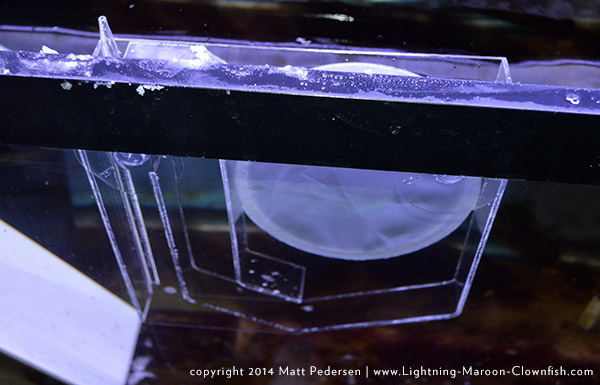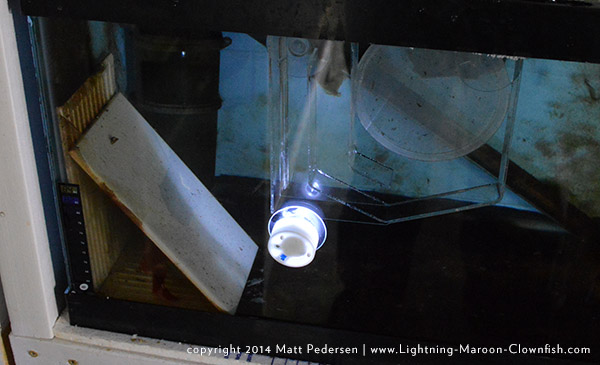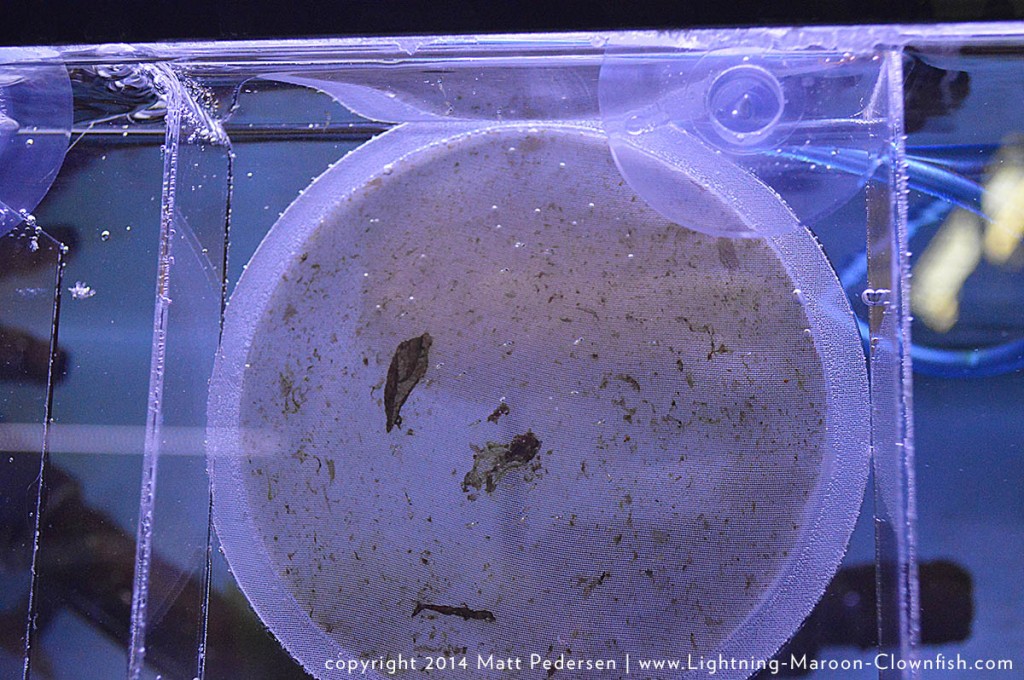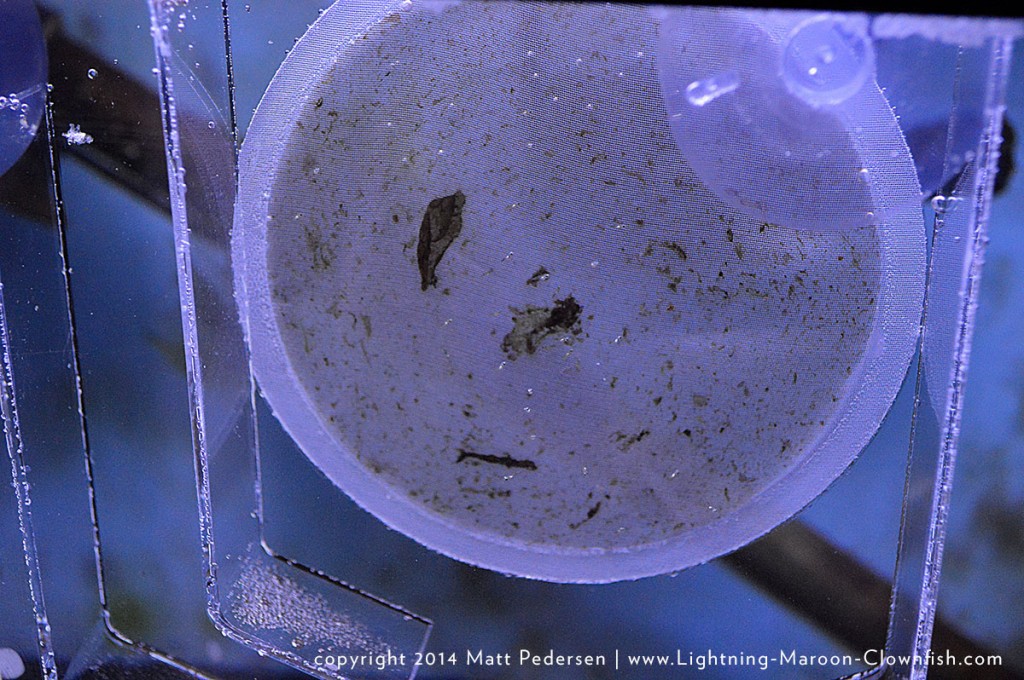First, I must go back to 5/25/2014, Sunday night, when I discovered that spawn #33 had been laid. So hatch should come this Saturday night.
Many people have asked when the next Lightning Maroon Clownfish will be sold. You may recall last fall that Blue Zoo stated they were going to auction 6, but then only auctioned 3. In short, weather in Duluth got brutally cold and never let up, meaning we never could safely ship. We had snow on the ground well into MAY this year…60+ days of temps that never made it ABOVE 0F. In short, Blue Zoo Aquatics is ready to auction more Lightning Maroons. It is currently me, at the moment, holding up the process (I need to get them the materials). Either way, it’s time to be on alert, and to start watching newsletters and emails and eBay. I presume as soon as I get my butt in gear, Blue Zoo will be offering them up.
- About The Lightning Project
- Inventory of F1 PNG Lightning and White Stripe Maroon Clownfish
- F1 PNG Lightning Maroon Clownfish, BZLM1
- F1 PNG Lightning Maroon Clownfish, BZLM2
- F1 PNG Lightning Maroon Clownfish, FW1
- F1 PNG Lightning Maroon Clownfish, LM10
- F1 PNG Lightning Maroon Clownfish, LM11
- F1 PNG Lightning Maroon Clownfish, LM12
- F1 PNG Lightning Maroon Clownfish, LM13
- F1 PNG Lightning Maroon Clownfish, LM14
- F1 PNG Lightning Maroon Clownfish, LM15
- F1 PNG Lightning Maroon Clownfish, LM16
- F1 PNG Lightning Maroon Clownfish, LM17
- F1 PNG Lightning Maroon Clownfish, LM18
- F1 PNG Lightning Maroon Clownfish, LM19
- F1 PNG Lightning Maroon Clownfish, LM20
- F1 PNG Lightning Maroon Clownfish, LM3
- F1 PNG Lightning Maroon Clownfish, LM4
- F1 PNG Lightning Maroon Clownfish, LM5
- F1 PNG Lightning Maroon Clownfish, LM6
- F1 PNG Lightning Maroon Clownfish, LM7
- F1 PNG Lightning Maroon Clownfish, LM8
- F1 PNG Lightning Maroon Clownfish, LM9
- F1 PNG Lightning Maroon Clownfish, MD1
- F1 PNG Lightning Maroon Clownfish, MWP3
- F1 PNG Lightning Maroon Clownfish, WS17
- F1 PNG Lightning Maroon, EC1
- F1 PNG Lightning Maroon, GL1
- F1 PNG White Stripe Maroon Clownfish, BZWS1
- F1 PNG White Stripe Maroon Clownfish, BZWS2
- F1 PNG White Stripe Maroon Clownfish, BZWS3
- F1 PNG White Stripe Maroon Clownfish, WS10
- F1 PNG White Stripe Maroon Clownfish, WS11
- F1 PNG White Stripe Maroon Clownfish, WS12
- F1 PNG White Stripe Maroon Clownfish, WS13
- F1 PNG White Stripe Maroon Clownfish, WS14
- F1 PNG White Stripe Maroon Clownfish, WS15
- F1 PNG White Stripe Maroon Clownfish, WS16
- F1 PNG White Stripe Maroon Clownfish, WS4
- F1 PNG White Stripe Maroon Clownfish, WS5
- F1 PNG White Stripe Maroon Clownfish, WS6
- F1 PNG White Stripe Maroon Clownfish, WS7
- F1 PNG White Stripe Maroon Clownfish, WS8
- F1 PNG White Stripe Maroon Clownfish, WS9
- F1 PNG White Stripe Maroon, EC2
- F1 PNG White Stripe Maroon, FW2
- F1 PNG White Stripe Maroon, GL2
- F1 PNG White Stripe Maroon, MD2
- Lightning Breeding Directive
- Lightning Maroon Clownfish Links
- Home
- About The Lightning Project
- Inventory of F1 PNG Lightning and White Stripe Maroon Clownfish
- F1 PNG Lightning Maroon Clownfish, BZLM1
- F1 PNG Lightning Maroon Clownfish, BZLM2
- F1 PNG Lightning Maroon Clownfish, FW1
- F1 PNG Lightning Maroon Clownfish, LM10
- F1 PNG Lightning Maroon Clownfish, LM11
- F1 PNG Lightning Maroon Clownfish, LM12
- F1 PNG Lightning Maroon Clownfish, LM13
- F1 PNG Lightning Maroon Clownfish, LM14
- F1 PNG Lightning Maroon Clownfish, LM15
- F1 PNG Lightning Maroon Clownfish, LM16
- F1 PNG Lightning Maroon Clownfish, LM17
- F1 PNG Lightning Maroon Clownfish, LM18
- F1 PNG Lightning Maroon Clownfish, LM19
- F1 PNG Lightning Maroon Clownfish, LM20
- F1 PNG Lightning Maroon Clownfish, LM3
- F1 PNG Lightning Maroon Clownfish, LM4
- F1 PNG Lightning Maroon Clownfish, LM5
- F1 PNG Lightning Maroon Clownfish, LM6
- F1 PNG Lightning Maroon Clownfish, LM7
- F1 PNG Lightning Maroon Clownfish, LM8
- F1 PNG Lightning Maroon Clownfish, LM9
- F1 PNG Lightning Maroon Clownfish, MD1
- F1 PNG Lightning Maroon Clownfish, MWP3
- F1 PNG Lightning Maroon Clownfish, WS17
- F1 PNG Lightning Maroon, EC1
- F1 PNG Lightning Maroon, GL1
- F1 PNG White Stripe Maroon Clownfish, BZWS1
- F1 PNG White Stripe Maroon Clownfish, BZWS2
- F1 PNG White Stripe Maroon Clownfish, BZWS3
- F1 PNG White Stripe Maroon Clownfish, WS10
- F1 PNG White Stripe Maroon Clownfish, WS11
- F1 PNG White Stripe Maroon Clownfish, WS12
- F1 PNG White Stripe Maroon Clownfish, WS13
- F1 PNG White Stripe Maroon Clownfish, WS14
- F1 PNG White Stripe Maroon Clownfish, WS15
- F1 PNG White Stripe Maroon Clownfish, WS16
- F1 PNG White Stripe Maroon Clownfish, WS4
- F1 PNG White Stripe Maroon Clownfish, WS5
- F1 PNG White Stripe Maroon Clownfish, WS6
- F1 PNG White Stripe Maroon Clownfish, WS7
- F1 PNG White Stripe Maroon Clownfish, WS8
- F1 PNG White Stripe Maroon Clownfish, WS9
- F1 PNG White Stripe Maroon, EC2
- F1 PNG White Stripe Maroon, FW2
- F1 PNG White Stripe Maroon, GL2
- F1 PNG White Stripe Maroon, MD2
- Lightning Breeding Directive
- Lightning Maroon Clownfish Links
On 5/21/2014, initially the hatch didn’t appear so good, but by afternoon, it was clear I had a solid hatch with hundreds in the BRT. I checked the tile, looked like 50% had hatched perhaps, so I let it go in the BRT overnight again, with only ambient light. THAT might have been a mistake, because this morning, there was no additional hatch, but many of the larvae had perished. Seems like I have a pretty reliable hatching protocol with H2O2 dip and broodstock water yielding reliable results on the first night. Moving the batch for a second night hatch might just be the ticket. The OTHER interesting thing – I do have to wonder if we have hatches going on during the day. I’ve long since wondered if that could be happening…
On the other front, Mike sent me an update video of Spawn #27.
Looks like I’m gonna owe him a Gold Nugget Maroon from ORA.
Based on my calculations, 5/20 is the night we’re due to first have hatches. Having moved all the fry from Spawn #30 into a BRT “on the system”, I wiped down and drained their BRT, and refilled it with water from the Lightning Maroon’s broodstock aquarium. The tile with eggs (huge nest, 4″ X 2″) was placed in a 0.5 gallon specimen cup with 4 ml H2O2 for approximately 15 minutes, after which it was set up with a coarse airstone for hatching in the BRT. I confirmed that the air is flowing directly over the eggs at a moderate clip. This *should* be a good hatch if I’ve done things right.
Side note on spawn #30 – ultimately the split was a nice dice roll – 8 Lightnings and only 3 White Stripes.
As of 5/13/2014, there were two fish from spawn #30 who had yet to undergo metamorphosis; the rest had. Trying to avoid past issues of small groups doing well and then just dying randomly, I selected 3 lightning juveniles and moved them into an empty black round tub that’s running on the larviculture system. When 5/14/2014 came around, and those 3 test subjects remained alive, I transferred over 3 more Lightnings and one White Stripe offspring. This leaves 1 White Stripe, 1 Lighting, and 2 unsettled juveniles in the larviculture BRT as of 5/15/2014.
In other news, the Lightning pair put down Spawn #32 on the slanted tile sometime in the afternoon/evening of 5/14/2014.
Then, there is the mystery. I don’t recall what spawn these offspring are from at the moment, but I had a small group of 5 growing up in a BRT; what amounted to 3 Lightnings and 2 white stripes. Mysteriously one day, all the Lightnings went missing. I presumed there had been fighting and jumps, but I never found bodies on the floor. This evening, when doing my feedings, I discovered one of those missing Lightnings sitting on the bottom of a cube tank on the top run. This would seem to confirm that the babies did jump, although perhaps they either went down the overflow or otherwise landed in the sump beneath, and this one apparently made it through the PUMP (WOW) along with a small Onyx Percula (also discovered in the tank today)?! At least that’s the only possible explanation I have, but wow, I am shocked that these fish would have made it through the pump at all…they weren’t that small!
I can only say this is bizzare. I have yet to give the sump a more thorough examination tonight with a flash light, but I would not be surprised to find a couple more clownfish hiding in the dark down there! The Onxy Perc and the single lightning were both placed back onto the Onyx Percula tub for the time being; frankly the Lightning did not look to be in good shape, and I would not be surprised if it doesn’t make it.
There are still maybe 2 larvae from Spawn #30 that haven’t settled. The dice roll so far seems to be heavy towards Lightning offspring…but all told there are probably 10 fish or so that made it.
Spawn #31 simply didn’t work out. The timers on the filtration worked flawlessly, but for some reason the eggs simply never hatched. After a very small hatch on the 6th night, the eggs remained and nothing hatched on the 7th, and after the 8th night they still were there, and vanished at some point during the day. I’m presuming they had died, not hatched. I ultimately didn’t bother to start a run…clearly my problems with hatching are not necessarily due to my artificial incubation methodologies, but something more fundamental.
As near as I can tell, a lot of eggs likely hatched from the PNG White Stripe Maroon Clownfish pair’s 2nd spawn. There are probably less than 50 eggs left. Of course, this was a tiny nest to start with (compared to other Maroon nests) so I opted to just leave the few remaining eggs to fend for themselves tonight. Last night would’ve been the “6th night” by my count, with tonight being the 7th night post spawn for these eggs. I am hoping for a larger spawn and one that comes soon!
It’s just after 2 AM on May 6th, 2014, and I’ve prepared everything for an in-tank hatch with the Vossen Larval Snagger tonight. By my count, this is the 6th night post hatch, the nest looks full and ready to go. I took my own advice and set up the system’s pumps on a timer. All water pumps shut off at 2 AM, and will turn on around 4 AM. If this works well, I can simply move the 3-plug outlet (which runs internal filter, skimmer and internal UV) onto another outlet on the main power strip when not in use, but on hatch nights where I want to snag, I can just plug it into the timer (thus never having to reset the timer).
If I’m up still in an hour or so I’ll check the snagger to see what I caught so far…
Also ,the few larvae I snagged from Spawn #30 are going through settlement at this time; they have only been offered rotifers, no other feeds, with RotiGreen Omega for greenwater. A few have headstripes, and the rest should be getting near.
Before I forget – sometime on the afternoon of April 30th, 2014, Spawn #31 was laid. That is all 😉
Yesterday, 4-29, I discovered a clutch of eggs from the OTHER F0 White Stipe PNG Maroon Clown pairing in the basement. If I recall correctly, this is only the 2nd clutch I’ve discovered from them. I’ll certainly try to raise some, just to see what I get and for outcross purposes.
Spawn #30 has a few babies still going…we’ll see…
I decided to try something different this time…I’d been putting it off but figured “might as well”. I decided to try snagging a hatch with the Vossen Aquatics Larval Snagger (aka. Larval Trap).
Thursday night, the 24th, was officially the 6th night post spawn and assuredly I’d get a hatch. I reconfigured the broodstock tank slightly to allow me to pull all the cords for water current devices in one shot. I thought about simply using a light timer to turn pumps off before lights out, and then on two hours later, but with the Lightning Maroons, I wasn’t going to risk it. I’d rather stay up late and BE SURE I got everything back up and running.
I set up the larval snagger in the broodstock tank and was sure to get the placement correct – the top of the snagger must reside above the water’s surface, as shown here.


After that, I made sure to get the air flowing, which runs water through the trap gently, without harming the larvae.

Then, set up the suction cup light, which serves to attract the larvae to the intake of the trap. Turn off all the lights in the room, and walk away for a couple hours…

I checked around 4:30 AM and saw that I had snagged a few larvae, but not many. The nest still looked rather full, and I scanned the tank for wayward larvae, using my cell phone’s flashlight feature. I didn’t see any, so this was a very weak / small hatch. It wasn’t enough to really try rearing, so I just figured I’d leave them in the trap and take some photos come morning. This is what I found when I checked.


It didn’t seem like nearly enough to bother a run with, so I left the snagger running all day and figured I’d simply try again on Friday night.
Unfortuantely, I might have screwed up on Friday night. I can’t be sure, but here’s what happened. The nest looked full most of the day, but I had shifted the light timing just a little bit. So the lights on the system went off at 2 AM vs. 2:30 AM, but I didn’t make it down into the basement to turn off the filtration until 2:30. The nest appeared to have hatched significantly before I had a chance to set things up.
I checked at 4:30 AM, and sadly I found one wayward larvae in the tank, and it appeared that the trap had maybe only captured a few more. Did I “miss” the hatch window Friday night? Possibly. I set up the larvae I had captured in a clean BRT with 8 gallons of broodstock water, rotifers, and some RotiGreen Omega, and that was it. I was gone Saturday night, so wasn’t able to see if I’d get any more on the 8th night.
Overall, based on the number of larvae caught vs. the number of larvae found in the tank, it’s fair to say that the snagger probably did perform well. I’ll probably try it again on batch 31, and maybe this next time I’ll TEST a timer and trust it to do my bidding. Maybe a little more automation will allow me to “score big” on a hatch in the broodstock tank, avoiding some of the problems I’ve encountered when artificially hatching.
Yeah, spawn #30 was laid on 4-18-2014; I noticed it in the evening when feeding. Large pale-orange batch on the far end of the vertical tile in their “tile tepee”. That’s all.
Recent Comments